Dissertation: Health and Safety in Myanmar Construction Projects
VerifiedAdded on 2020/03/28
|81
|21099
|85
Dissertation
AI Summary
This dissertation investigates health and safety management within construction projects, specifically focusing on the context of Myanmar. The research explores the significance of implementing health and safety measures to ensure successful project outcomes, addressing the high incidence of accidents and injuries in the construction industry. The study delves into various risk factors, hazards, and potential mitigation strategies, including international safety standards and regulations. The methodology encompasses literature review, and data analysis to identify key issues and recommend improvements in health and safety practices. The dissertation covers the construction industry, stakeholder management, and the importance of safety and health as a critical element for the economic development of Myanmar. The paper examines the construction industries in Myanmar, and recommends a health and safety management system to overcome the dangerous situations normally experienced. The study includes a comprehensive analysis of relevant literature, data collection and analysis, and provides recommendations for enhancing safety protocols and minimizing risks within the construction sector. This dissertation is a valuable resource for understanding and improving health and safety practices in construction projects.
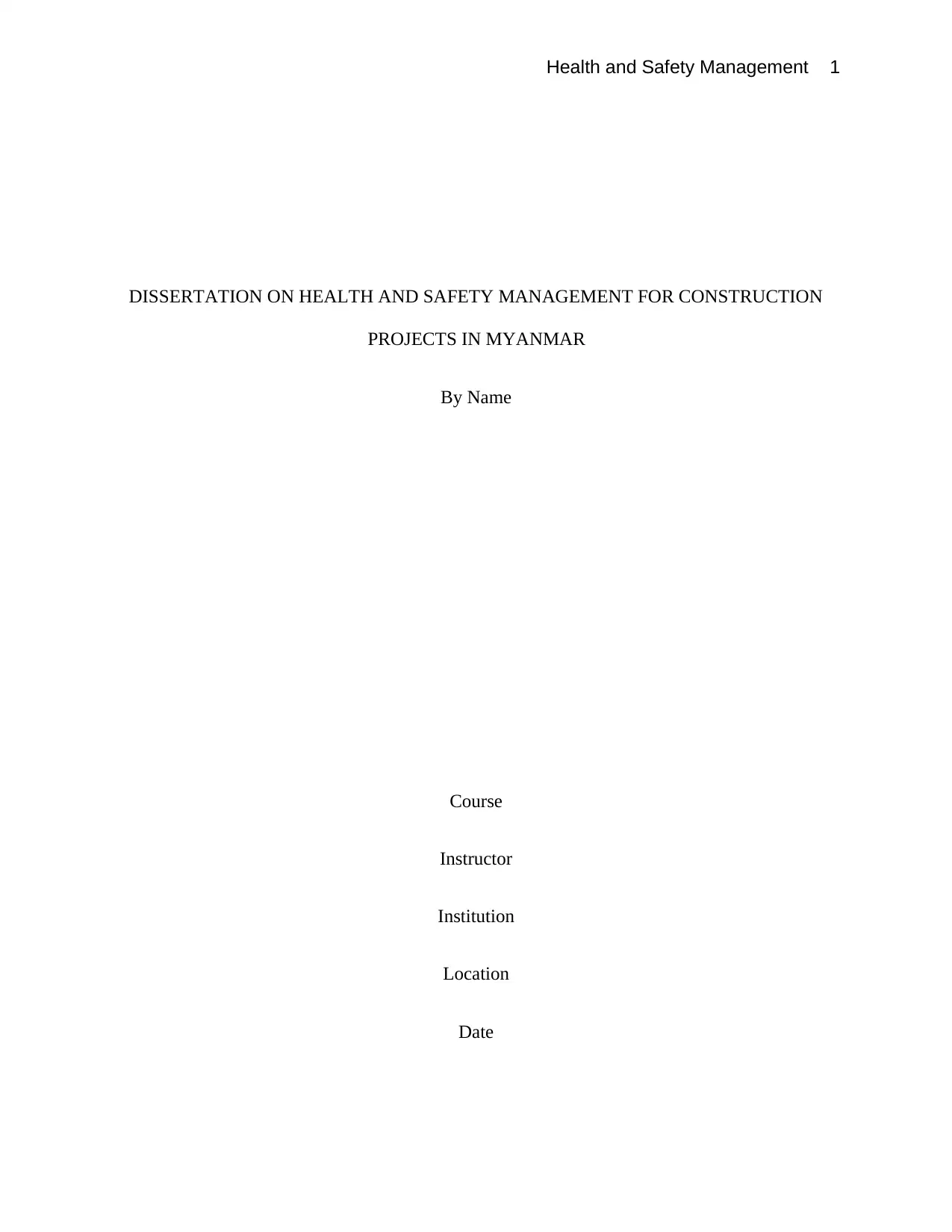
Health and Safety Management 1
DISSERTATION ON HEALTH AND SAFETY MANAGEMENT FOR CONSTRUCTION
PROJECTS IN MYANMAR
By Name
Course
Instructor
Institution
Location
Date
DISSERTATION ON HEALTH AND SAFETY MANAGEMENT FOR CONSTRUCTION
PROJECTS IN MYANMAR
By Name
Course
Instructor
Institution
Location
Date
Paraphrase This Document
Need a fresh take? Get an instant paraphrase of this document with our AI Paraphraser
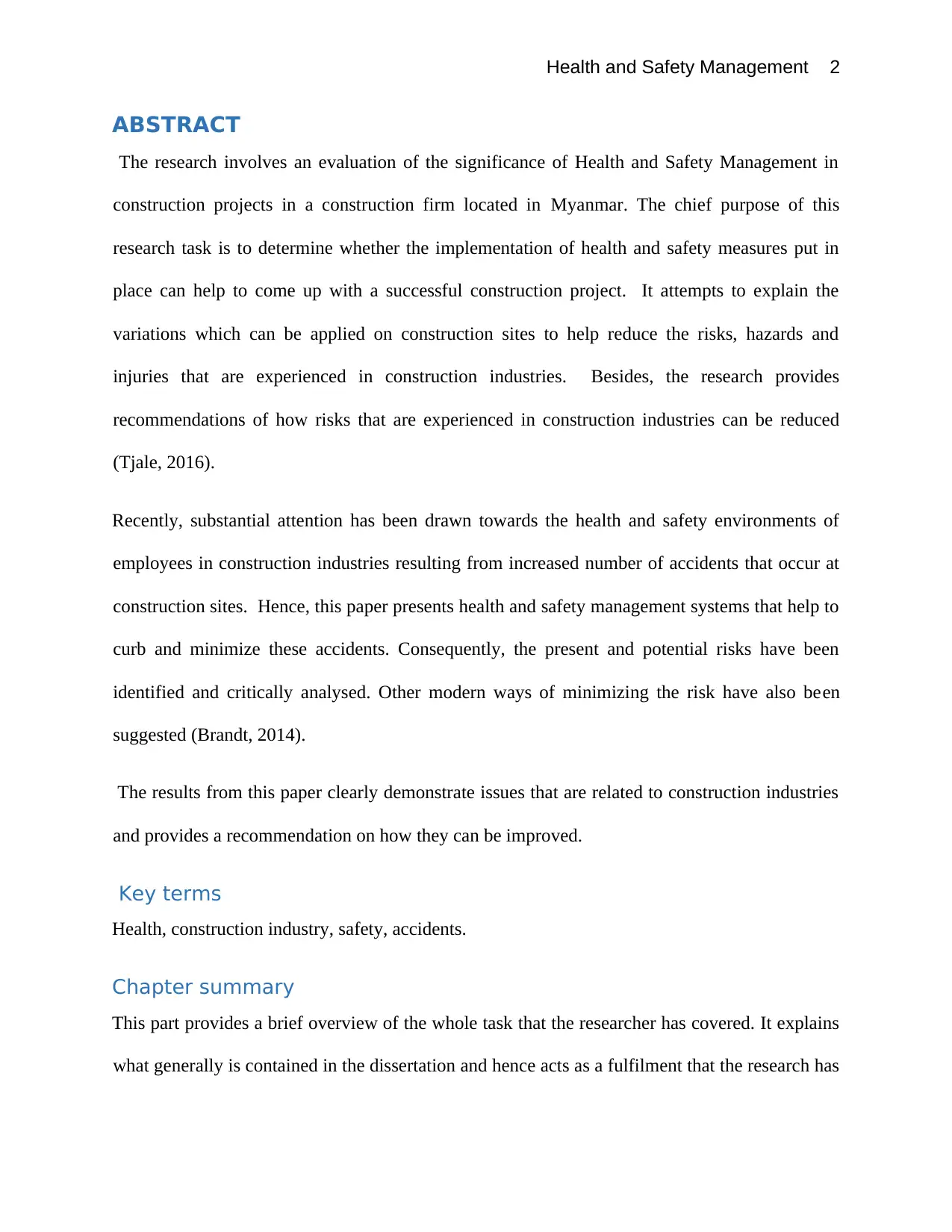
Health and Safety Management 2
ABSTRACT
The research involves an evaluation of the significance of Health and Safety Management in
construction projects in a construction firm located in Myanmar. The chief purpose of this
research task is to determine whether the implementation of health and safety measures put in
place can help to come up with a successful construction project. It attempts to explain the
variations which can be applied on construction sites to help reduce the risks, hazards and
injuries that are experienced in construction industries. Besides, the research provides
recommendations of how risks that are experienced in construction industries can be reduced
(Tjale, 2016).
Recently, substantial attention has been drawn towards the health and safety environments of
employees in construction industries resulting from increased number of accidents that occur at
construction sites. Hence, this paper presents health and safety management systems that help to
curb and minimize these accidents. Consequently, the present and potential risks have been
identified and critically analysed. Other modern ways of minimizing the risk have also been
suggested (Brandt, 2014).
The results from this paper clearly demonstrate issues that are related to construction industries
and provides a recommendation on how they can be improved.
Key terms
Health, construction industry, safety, accidents.
Chapter summary
This part provides a brief overview of the whole task that the researcher has covered. It explains
what generally is contained in the dissertation and hence acts as a fulfilment that the research has
ABSTRACT
The research involves an evaluation of the significance of Health and Safety Management in
construction projects in a construction firm located in Myanmar. The chief purpose of this
research task is to determine whether the implementation of health and safety measures put in
place can help to come up with a successful construction project. It attempts to explain the
variations which can be applied on construction sites to help reduce the risks, hazards and
injuries that are experienced in construction industries. Besides, the research provides
recommendations of how risks that are experienced in construction industries can be reduced
(Tjale, 2016).
Recently, substantial attention has been drawn towards the health and safety environments of
employees in construction industries resulting from increased number of accidents that occur at
construction sites. Hence, this paper presents health and safety management systems that help to
curb and minimize these accidents. Consequently, the present and potential risks have been
identified and critically analysed. Other modern ways of minimizing the risk have also been
suggested (Brandt, 2014).
The results from this paper clearly demonstrate issues that are related to construction industries
and provides a recommendation on how they can be improved.
Key terms
Health, construction industry, safety, accidents.
Chapter summary
This part provides a brief overview of the whole task that the researcher has covered. It explains
what generally is contained in the dissertation and hence acts as a fulfilment that the research has
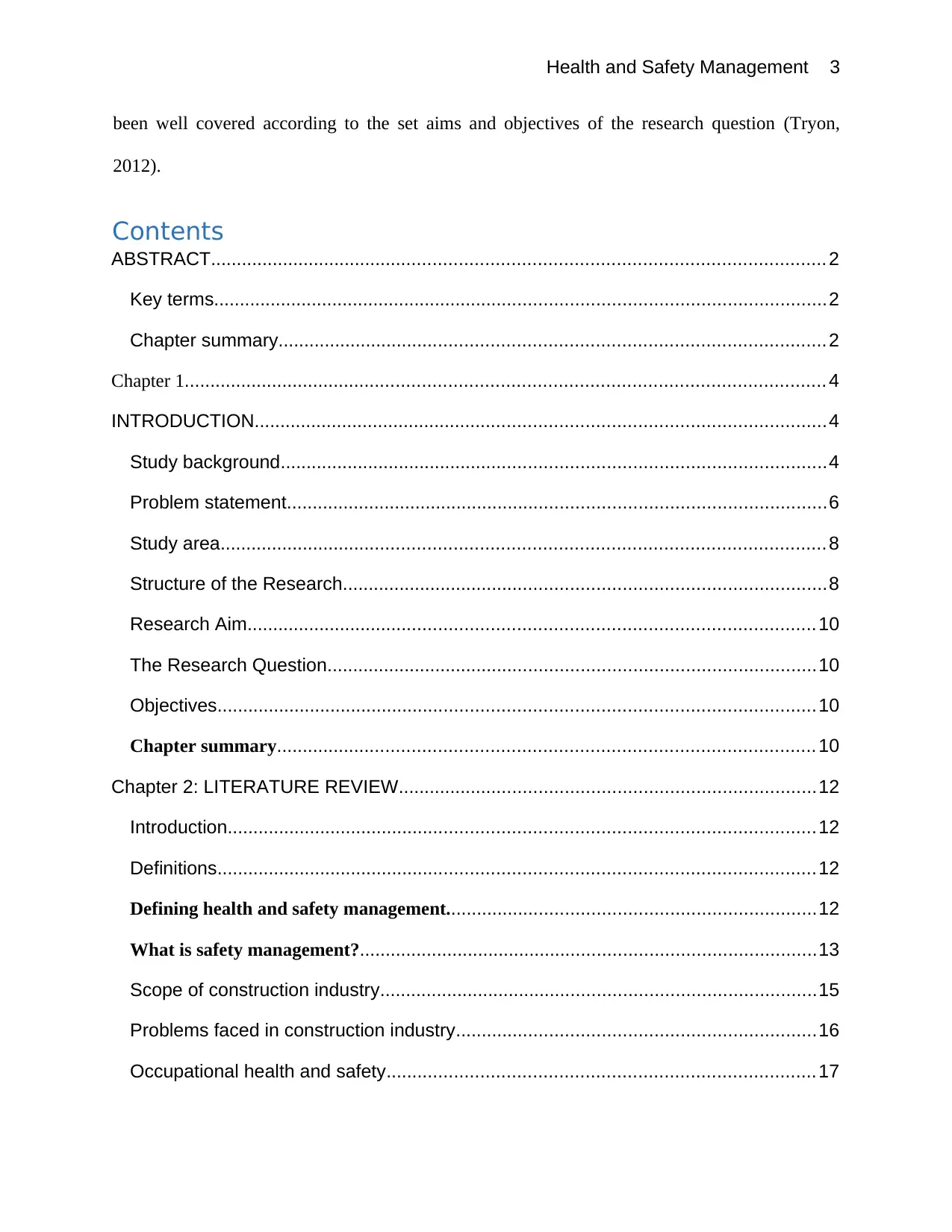
Health and Safety Management 3
been well covered according to the set aims and objectives of the research question (Tryon,
2012).
Contents
ABSTRACT...................................................................................................................... 2
Key terms......................................................................................................................2
Chapter summary......................................................................................................... 2
Chapter 1........................................................................................................................... 4
INTRODUCTION..............................................................................................................4
Study background.........................................................................................................4
Problem statement........................................................................................................6
Study area.................................................................................................................... 8
Structure of the Research.............................................................................................8
Research Aim............................................................................................................. 10
The Research Question..............................................................................................10
Objectives...................................................................................................................10
Chapter summary....................................................................................................... 10
Chapter 2: LITERATURE REVIEW................................................................................12
Introduction.................................................................................................................12
Definitions...................................................................................................................12
Defining health and safety management.......................................................................12
What is safety management?........................................................................................13
Scope of construction industry....................................................................................15
Problems faced in construction industry.....................................................................16
Occupational health and safety.................................................................................. 17
been well covered according to the set aims and objectives of the research question (Tryon,
2012).
Contents
ABSTRACT...................................................................................................................... 2
Key terms......................................................................................................................2
Chapter summary......................................................................................................... 2
Chapter 1........................................................................................................................... 4
INTRODUCTION..............................................................................................................4
Study background.........................................................................................................4
Problem statement........................................................................................................6
Study area.................................................................................................................... 8
Structure of the Research.............................................................................................8
Research Aim............................................................................................................. 10
The Research Question..............................................................................................10
Objectives...................................................................................................................10
Chapter summary....................................................................................................... 10
Chapter 2: LITERATURE REVIEW................................................................................12
Introduction.................................................................................................................12
Definitions...................................................................................................................12
Defining health and safety management.......................................................................12
What is safety management?........................................................................................13
Scope of construction industry....................................................................................15
Problems faced in construction industry.....................................................................16
Occupational health and safety.................................................................................. 17
⊘ This is a preview!⊘
Do you want full access?
Subscribe today to unlock all pages.

Trusted by 1+ million students worldwide
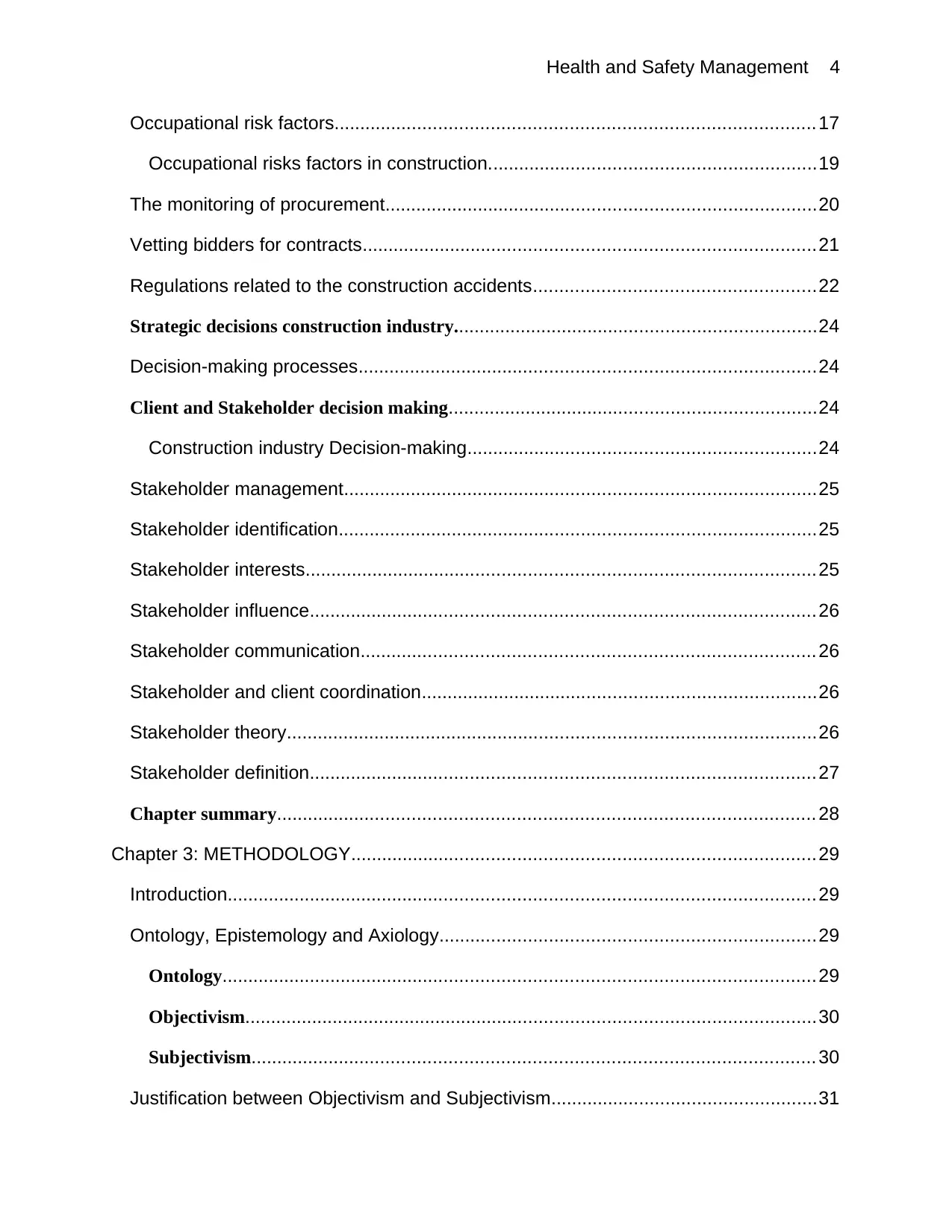
Health and Safety Management 4
Occupational risk factors............................................................................................ 17
Occupational risks factors in construction...............................................................19
The monitoring of procurement...................................................................................20
Vetting bidders for contracts.......................................................................................21
Regulations related to the construction accidents......................................................22
Strategic decisions construction industry......................................................................24
Decision-making processes........................................................................................24
Client and Stakeholder decision making.......................................................................24
Construction industry Decision-making...................................................................24
Stakeholder management...........................................................................................25
Stakeholder identification............................................................................................25
Stakeholder interests..................................................................................................25
Stakeholder influence.................................................................................................26
Stakeholder communication....................................................................................... 26
Stakeholder and client coordination............................................................................26
Stakeholder theory......................................................................................................26
Stakeholder definition.................................................................................................27
Chapter summary....................................................................................................... 28
Chapter 3: METHODOLOGY.........................................................................................29
Introduction.................................................................................................................29
Ontology, Epistemology and Axiology........................................................................29
Ontology..................................................................................................................29
Objectivism..............................................................................................................30
Subjectivism............................................................................................................ 30
Justification between Objectivism and Subjectivism...................................................31
Occupational risk factors............................................................................................ 17
Occupational risks factors in construction...............................................................19
The monitoring of procurement...................................................................................20
Vetting bidders for contracts.......................................................................................21
Regulations related to the construction accidents......................................................22
Strategic decisions construction industry......................................................................24
Decision-making processes........................................................................................24
Client and Stakeholder decision making.......................................................................24
Construction industry Decision-making...................................................................24
Stakeholder management...........................................................................................25
Stakeholder identification............................................................................................25
Stakeholder interests..................................................................................................25
Stakeholder influence.................................................................................................26
Stakeholder communication....................................................................................... 26
Stakeholder and client coordination............................................................................26
Stakeholder theory......................................................................................................26
Stakeholder definition.................................................................................................27
Chapter summary....................................................................................................... 28
Chapter 3: METHODOLOGY.........................................................................................29
Introduction.................................................................................................................29
Ontology, Epistemology and Axiology........................................................................29
Ontology..................................................................................................................29
Objectivism..............................................................................................................30
Subjectivism............................................................................................................ 30
Justification between Objectivism and Subjectivism...................................................31
Paraphrase This Document
Need a fresh take? Get an instant paraphrase of this document with our AI Paraphraser
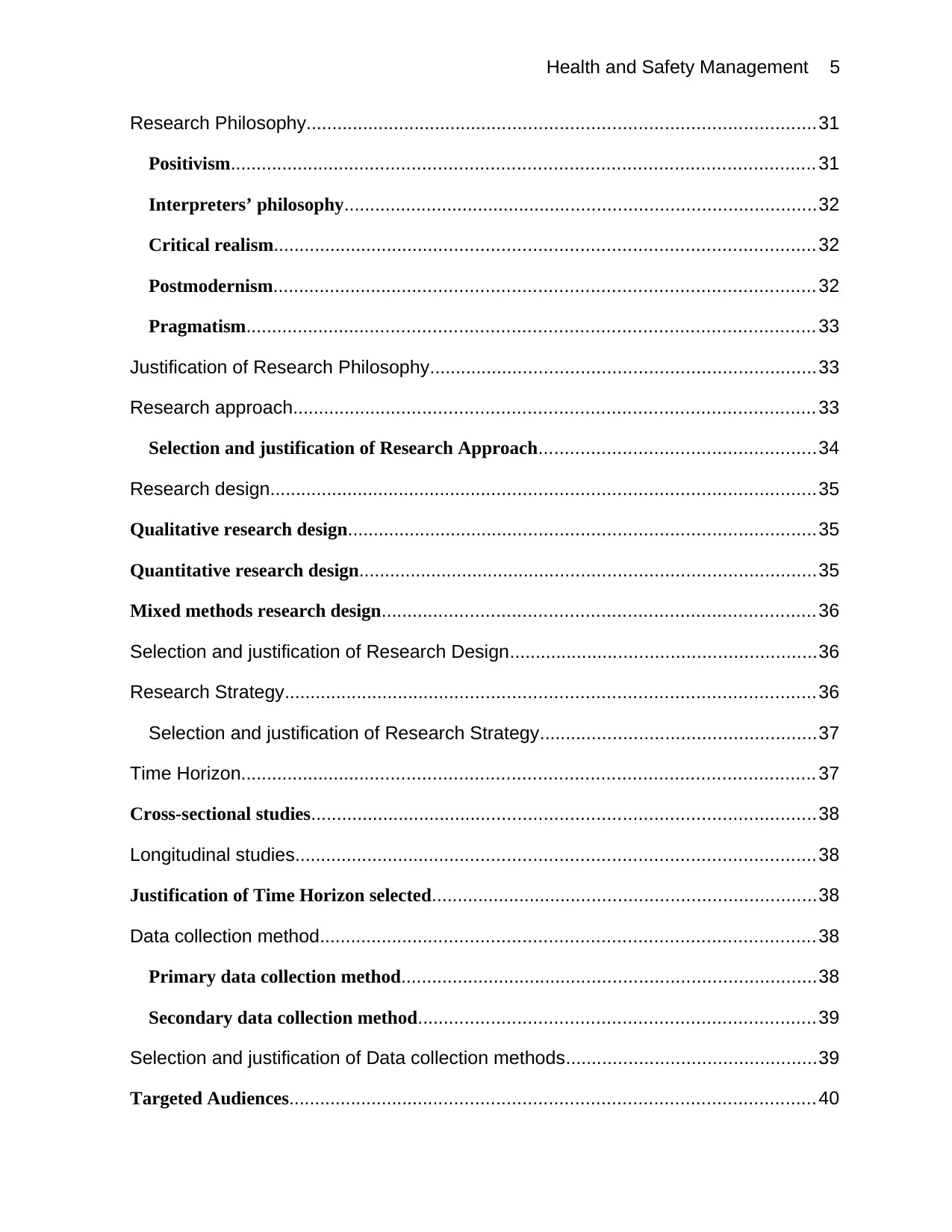
Health and Safety Management 5
Research Philosophy..................................................................................................31
Positivism................................................................................................................ 31
Interpreters’ philosophy...........................................................................................32
Critical realism........................................................................................................ 32
Postmodernism........................................................................................................ 32
Pragmatism............................................................................................................. 33
Justification of Research Philosophy..........................................................................33
Research approach.................................................................................................... 33
Selection and justification of Research Approach.....................................................34
Research design.........................................................................................................35
Qualitative research design..........................................................................................35
Quantitative research design........................................................................................35
Mixed methods research design...................................................................................36
Selection and justification of Research Design...........................................................36
Research Strategy......................................................................................................36
Selection and justification of Research Strategy.....................................................37
Time Horizon.............................................................................................................. 37
Cross-sectional studies.................................................................................................38
Longitudinal studies....................................................................................................38
Justification of Time Horizon selected..........................................................................38
Data collection method...............................................................................................38
Primary data collection method................................................................................38
Secondary data collection method............................................................................39
Selection and justification of Data collection methods................................................39
Targeted Audiences.....................................................................................................40
Research Philosophy..................................................................................................31
Positivism................................................................................................................ 31
Interpreters’ philosophy...........................................................................................32
Critical realism........................................................................................................ 32
Postmodernism........................................................................................................ 32
Pragmatism............................................................................................................. 33
Justification of Research Philosophy..........................................................................33
Research approach.................................................................................................... 33
Selection and justification of Research Approach.....................................................34
Research design.........................................................................................................35
Qualitative research design..........................................................................................35
Quantitative research design........................................................................................35
Mixed methods research design...................................................................................36
Selection and justification of Research Design...........................................................36
Research Strategy......................................................................................................36
Selection and justification of Research Strategy.....................................................37
Time Horizon.............................................................................................................. 37
Cross-sectional studies.................................................................................................38
Longitudinal studies....................................................................................................38
Justification of Time Horizon selected..........................................................................38
Data collection method...............................................................................................38
Primary data collection method................................................................................38
Secondary data collection method............................................................................39
Selection and justification of Data collection methods................................................39
Targeted Audiences.....................................................................................................40
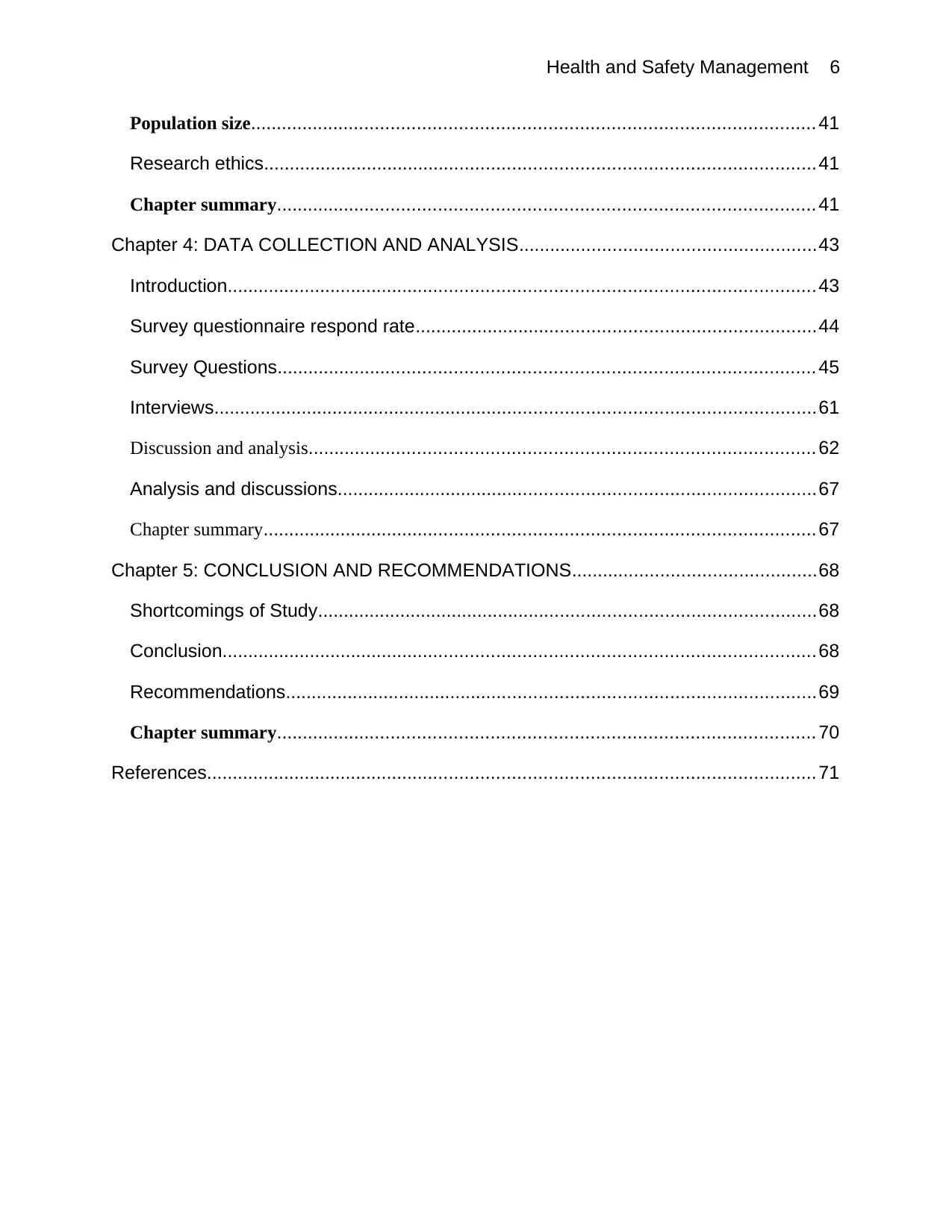
Health and Safety Management 6
Population size............................................................................................................ 41
Research ethics..........................................................................................................41
Chapter summary....................................................................................................... 41
Chapter 4: DATA COLLECTION AND ANALYSIS.........................................................43
Introduction.................................................................................................................43
Survey questionnaire respond rate.............................................................................44
Survey Questions....................................................................................................... 45
Interviews....................................................................................................................61
Discussion and analysis................................................................................................. 62
Analysis and discussions............................................................................................67
Chapter summary.......................................................................................................... 67
Chapter 5: CONCLUSION AND RECOMMENDATIONS...............................................68
Shortcomings of Study................................................................................................68
Conclusion..................................................................................................................68
Recommendations......................................................................................................69
Chapter summary....................................................................................................... 70
References..................................................................................................................... 71
Population size............................................................................................................ 41
Research ethics..........................................................................................................41
Chapter summary....................................................................................................... 41
Chapter 4: DATA COLLECTION AND ANALYSIS.........................................................43
Introduction.................................................................................................................43
Survey questionnaire respond rate.............................................................................44
Survey Questions....................................................................................................... 45
Interviews....................................................................................................................61
Discussion and analysis................................................................................................. 62
Analysis and discussions............................................................................................67
Chapter summary.......................................................................................................... 67
Chapter 5: CONCLUSION AND RECOMMENDATIONS...............................................68
Shortcomings of Study................................................................................................68
Conclusion..................................................................................................................68
Recommendations......................................................................................................69
Chapter summary....................................................................................................... 70
References..................................................................................................................... 71
⊘ This is a preview!⊘
Do you want full access?
Subscribe today to unlock all pages.

Trusted by 1+ million students worldwide
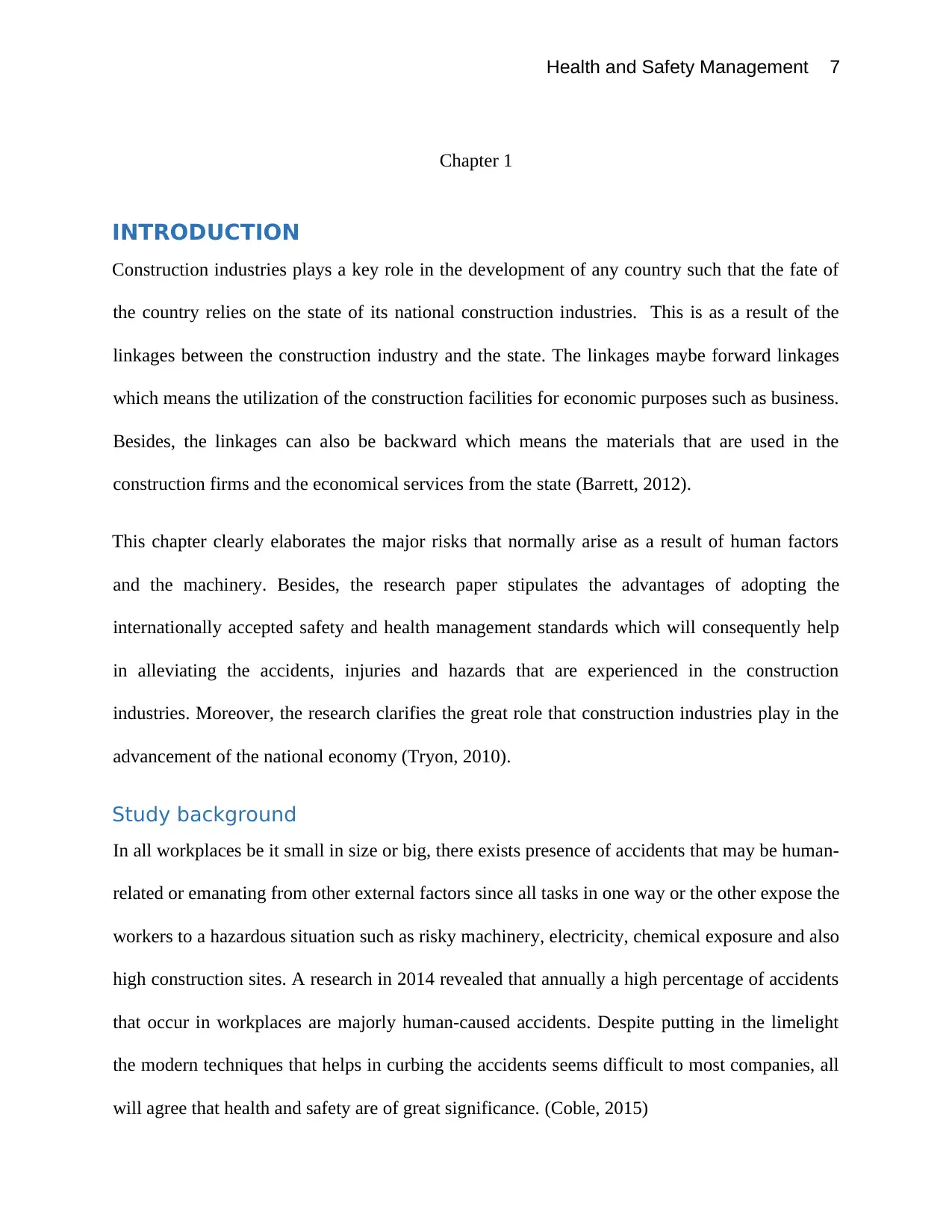
Health and Safety Management 7
Chapter 1
INTRODUCTION
Construction industries plays a key role in the development of any country such that the fate of
the country relies on the state of its national construction industries. This is as a result of the
linkages between the construction industry and the state. The linkages maybe forward linkages
which means the utilization of the construction facilities for economic purposes such as business.
Besides, the linkages can also be backward which means the materials that are used in the
construction firms and the economical services from the state (Barrett, 2012).
This chapter clearly elaborates the major risks that normally arise as a result of human factors
and the machinery. Besides, the research paper stipulates the advantages of adopting the
internationally accepted safety and health management standards which will consequently help
in alleviating the accidents, injuries and hazards that are experienced in the construction
industries. Moreover, the research clarifies the great role that construction industries play in the
advancement of the national economy (Tryon, 2010).
Study background
In all workplaces be it small in size or big, there exists presence of accidents that may be human-
related or emanating from other external factors since all tasks in one way or the other expose the
workers to a hazardous situation such as risky machinery, electricity, chemical exposure and also
high construction sites. A research in 2014 revealed that annually a high percentage of accidents
that occur in workplaces are majorly human-caused accidents. Despite putting in the limelight
the modern techniques that helps in curbing the accidents seems difficult to most companies, all
will agree that health and safety are of great significance. (Coble, 2015)
Chapter 1
INTRODUCTION
Construction industries plays a key role in the development of any country such that the fate of
the country relies on the state of its national construction industries. This is as a result of the
linkages between the construction industry and the state. The linkages maybe forward linkages
which means the utilization of the construction facilities for economic purposes such as business.
Besides, the linkages can also be backward which means the materials that are used in the
construction firms and the economical services from the state (Barrett, 2012).
This chapter clearly elaborates the major risks that normally arise as a result of human factors
and the machinery. Besides, the research paper stipulates the advantages of adopting the
internationally accepted safety and health management standards which will consequently help
in alleviating the accidents, injuries and hazards that are experienced in the construction
industries. Moreover, the research clarifies the great role that construction industries play in the
advancement of the national economy (Tryon, 2010).
Study background
In all workplaces be it small in size or big, there exists presence of accidents that may be human-
related or emanating from other external factors since all tasks in one way or the other expose the
workers to a hazardous situation such as risky machinery, electricity, chemical exposure and also
high construction sites. A research in 2014 revealed that annually a high percentage of accidents
that occur in workplaces are majorly human-caused accidents. Despite putting in the limelight
the modern techniques that helps in curbing the accidents seems difficult to most companies, all
will agree that health and safety are of great significance. (Coble, 2015)
Paraphrase This Document
Need a fresh take? Get an instant paraphrase of this document with our AI Paraphraser
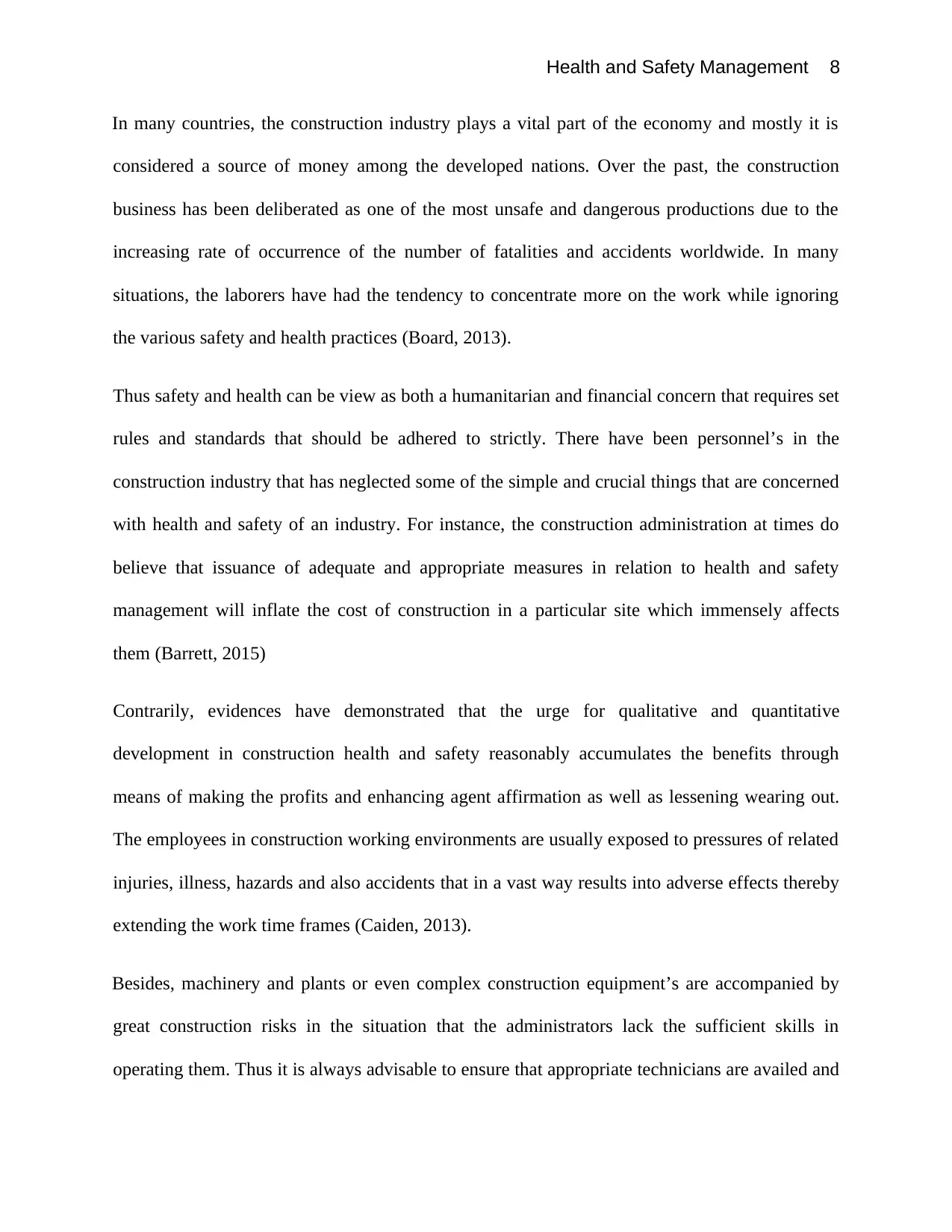
Health and Safety Management 8
In many countries, the construction industry plays a vital part of the economy and mostly it is
considered a source of money among the developed nations. Over the past, the construction
business has been deliberated as one of the most unsafe and dangerous productions due to the
increasing rate of occurrence of the number of fatalities and accidents worldwide. In many
situations, the laborers have had the tendency to concentrate more on the work while ignoring
the various safety and health practices (Board, 2013).
Thus safety and health can be view as both a humanitarian and financial concern that requires set
rules and standards that should be adhered to strictly. There have been personnel’s in the
construction industry that has neglected some of the simple and crucial things that are concerned
with health and safety of an industry. For instance, the construction administration at times do
believe that issuance of adequate and appropriate measures in relation to health and safety
management will inflate the cost of construction in a particular site which immensely affects
them (Barrett, 2015)
Contrarily, evidences have demonstrated that the urge for qualitative and quantitative
development in construction health and safety reasonably accumulates the benefits through
means of making the profits and enhancing agent affirmation as well as lessening wearing out.
The employees in construction working environments are usually exposed to pressures of related
injuries, illness, hazards and also accidents that in a vast way results into adverse effects thereby
extending the work time frames (Caiden, 2013).
Besides, machinery and plants or even complex construction equipment’s are accompanied by
great construction risks in the situation that the administrators lack the sufficient skills in
operating them. Thus it is always advisable to ensure that appropriate technicians are availed and
In many countries, the construction industry plays a vital part of the economy and mostly it is
considered a source of money among the developed nations. Over the past, the construction
business has been deliberated as one of the most unsafe and dangerous productions due to the
increasing rate of occurrence of the number of fatalities and accidents worldwide. In many
situations, the laborers have had the tendency to concentrate more on the work while ignoring
the various safety and health practices (Board, 2013).
Thus safety and health can be view as both a humanitarian and financial concern that requires set
rules and standards that should be adhered to strictly. There have been personnel’s in the
construction industry that has neglected some of the simple and crucial things that are concerned
with health and safety of an industry. For instance, the construction administration at times do
believe that issuance of adequate and appropriate measures in relation to health and safety
management will inflate the cost of construction in a particular site which immensely affects
them (Barrett, 2015)
Contrarily, evidences have demonstrated that the urge for qualitative and quantitative
development in construction health and safety reasonably accumulates the benefits through
means of making the profits and enhancing agent affirmation as well as lessening wearing out.
The employees in construction working environments are usually exposed to pressures of related
injuries, illness, hazards and also accidents that in a vast way results into adverse effects thereby
extending the work time frames (Caiden, 2013).
Besides, machinery and plants or even complex construction equipment’s are accompanied by
great construction risks in the situation that the administrators lack the sufficient skills in
operating them. Thus it is always advisable to ensure that appropriate technicians are availed and
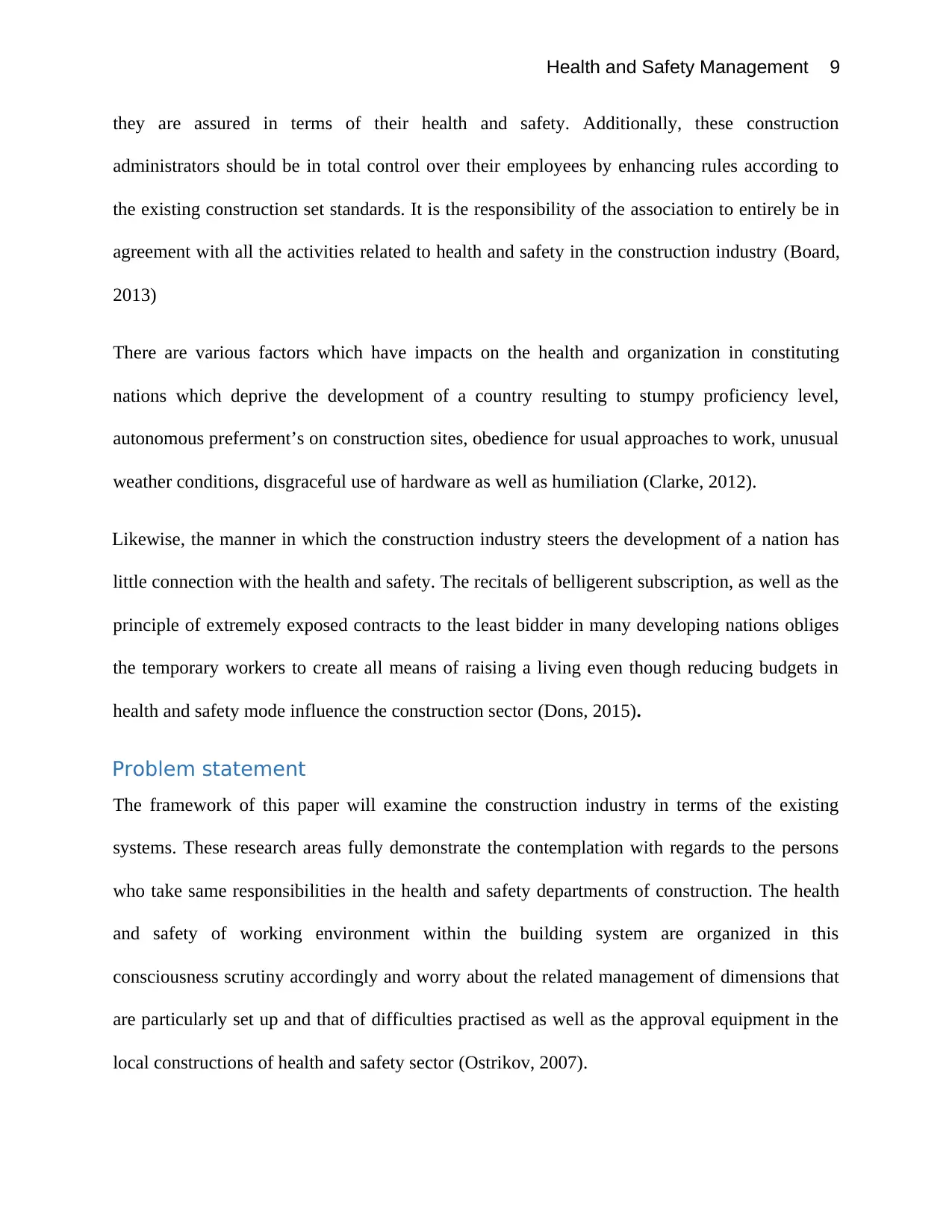
Health and Safety Management 9
they are assured in terms of their health and safety. Additionally, these construction
administrators should be in total control over their employees by enhancing rules according to
the existing construction set standards. It is the responsibility of the association to entirely be in
agreement with all the activities related to health and safety in the construction industry (Board,
2013)
There are various factors which have impacts on the health and organization in constituting
nations which deprive the development of a country resulting to stumpy proficiency level,
autonomous preferment’s on construction sites, obedience for usual approaches to work, unusual
weather conditions, disgraceful use of hardware as well as humiliation (Clarke, 2012).
Likewise, the manner in which the construction industry steers the development of a nation has
little connection with the health and safety. The recitals of belligerent subscription, as well as the
principle of extremely exposed contracts to the least bidder in many developing nations obliges
the temporary workers to create all means of raising a living even though reducing budgets in
health and safety mode influence the construction sector (Dons, 2015).
Problem statement
The framework of this paper will examine the construction industry in terms of the existing
systems. These research areas fully demonstrate the contemplation with regards to the persons
who take same responsibilities in the health and safety departments of construction. The health
and safety of working environment within the building system are organized in this
consciousness scrutiny accordingly and worry about the related management of dimensions that
are particularly set up and that of difficulties practised as well as the approval equipment in the
local constructions of health and safety sector (Ostrikov, 2007).
they are assured in terms of their health and safety. Additionally, these construction
administrators should be in total control over their employees by enhancing rules according to
the existing construction set standards. It is the responsibility of the association to entirely be in
agreement with all the activities related to health and safety in the construction industry (Board,
2013)
There are various factors which have impacts on the health and organization in constituting
nations which deprive the development of a country resulting to stumpy proficiency level,
autonomous preferment’s on construction sites, obedience for usual approaches to work, unusual
weather conditions, disgraceful use of hardware as well as humiliation (Clarke, 2012).
Likewise, the manner in which the construction industry steers the development of a nation has
little connection with the health and safety. The recitals of belligerent subscription, as well as the
principle of extremely exposed contracts to the least bidder in many developing nations obliges
the temporary workers to create all means of raising a living even though reducing budgets in
health and safety mode influence the construction sector (Dons, 2015).
Problem statement
The framework of this paper will examine the construction industry in terms of the existing
systems. These research areas fully demonstrate the contemplation with regards to the persons
who take same responsibilities in the health and safety departments of construction. The health
and safety of working environment within the building system are organized in this
consciousness scrutiny accordingly and worry about the related management of dimensions that
are particularly set up and that of difficulties practised as well as the approval equipment in the
local constructions of health and safety sector (Ostrikov, 2007).
⊘ This is a preview!⊘
Do you want full access?
Subscribe today to unlock all pages.

Trusted by 1+ million students worldwide
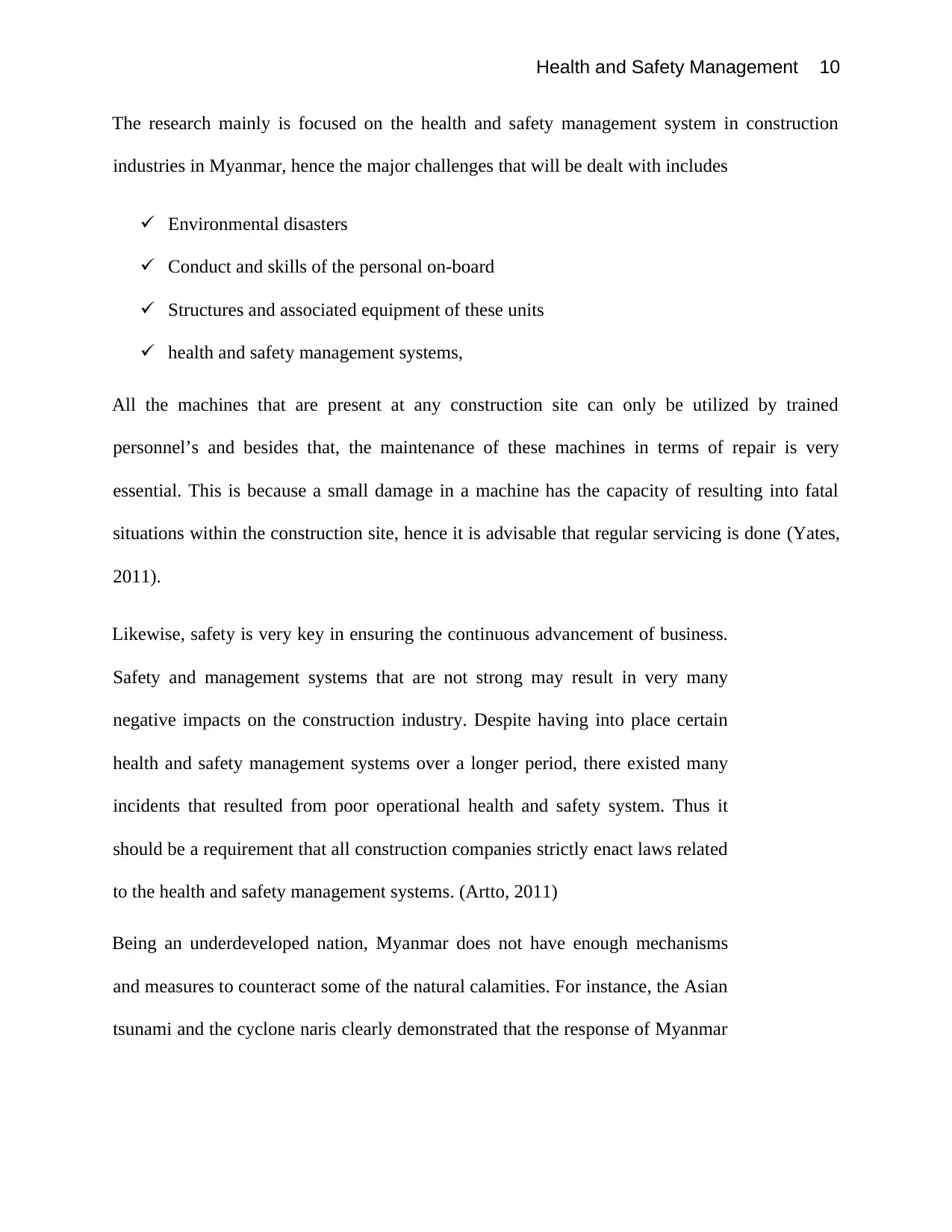
Health and Safety Management 10
The research mainly is focused on the health and safety management system in construction
industries in Myanmar, hence the major challenges that will be dealt with includes
Environmental disasters
Conduct and skills of the personal on-board
Structures and associated equipment of these units
health and safety management systems,
All the machines that are present at any construction site can only be utilized by trained
personnel’s and besides that, the maintenance of these machines in terms of repair is very
essential. This is because a small damage in a machine has the capacity of resulting into fatal
situations within the construction site, hence it is advisable that regular servicing is done (Yates,
2011).
Likewise, safety is very key in ensuring the continuous advancement of business.
Safety and management systems that are not strong may result in very many
negative impacts on the construction industry. Despite having into place certain
health and safety management systems over a longer period, there existed many
incidents that resulted from poor operational health and safety system. Thus it
should be a requirement that all construction companies strictly enact laws related
to the health and safety management systems. (Artto, 2011)
Being an underdeveloped nation, Myanmar does not have enough mechanisms
and measures to counteract some of the natural calamities. For instance, the Asian
tsunami and the cyclone naris clearly demonstrated that the response of Myanmar
The research mainly is focused on the health and safety management system in construction
industries in Myanmar, hence the major challenges that will be dealt with includes
Environmental disasters
Conduct and skills of the personal on-board
Structures and associated equipment of these units
health and safety management systems,
All the machines that are present at any construction site can only be utilized by trained
personnel’s and besides that, the maintenance of these machines in terms of repair is very
essential. This is because a small damage in a machine has the capacity of resulting into fatal
situations within the construction site, hence it is advisable that regular servicing is done (Yates,
2011).
Likewise, safety is very key in ensuring the continuous advancement of business.
Safety and management systems that are not strong may result in very many
negative impacts on the construction industry. Despite having into place certain
health and safety management systems over a longer period, there existed many
incidents that resulted from poor operational health and safety system. Thus it
should be a requirement that all construction companies strictly enact laws related
to the health and safety management systems. (Artto, 2011)
Being an underdeveloped nation, Myanmar does not have enough mechanisms
and measures to counteract some of the natural calamities. For instance, the Asian
tsunami and the cyclone naris clearly demonstrated that the response of Myanmar
Paraphrase This Document
Need a fresh take? Get an instant paraphrase of this document with our AI Paraphraser
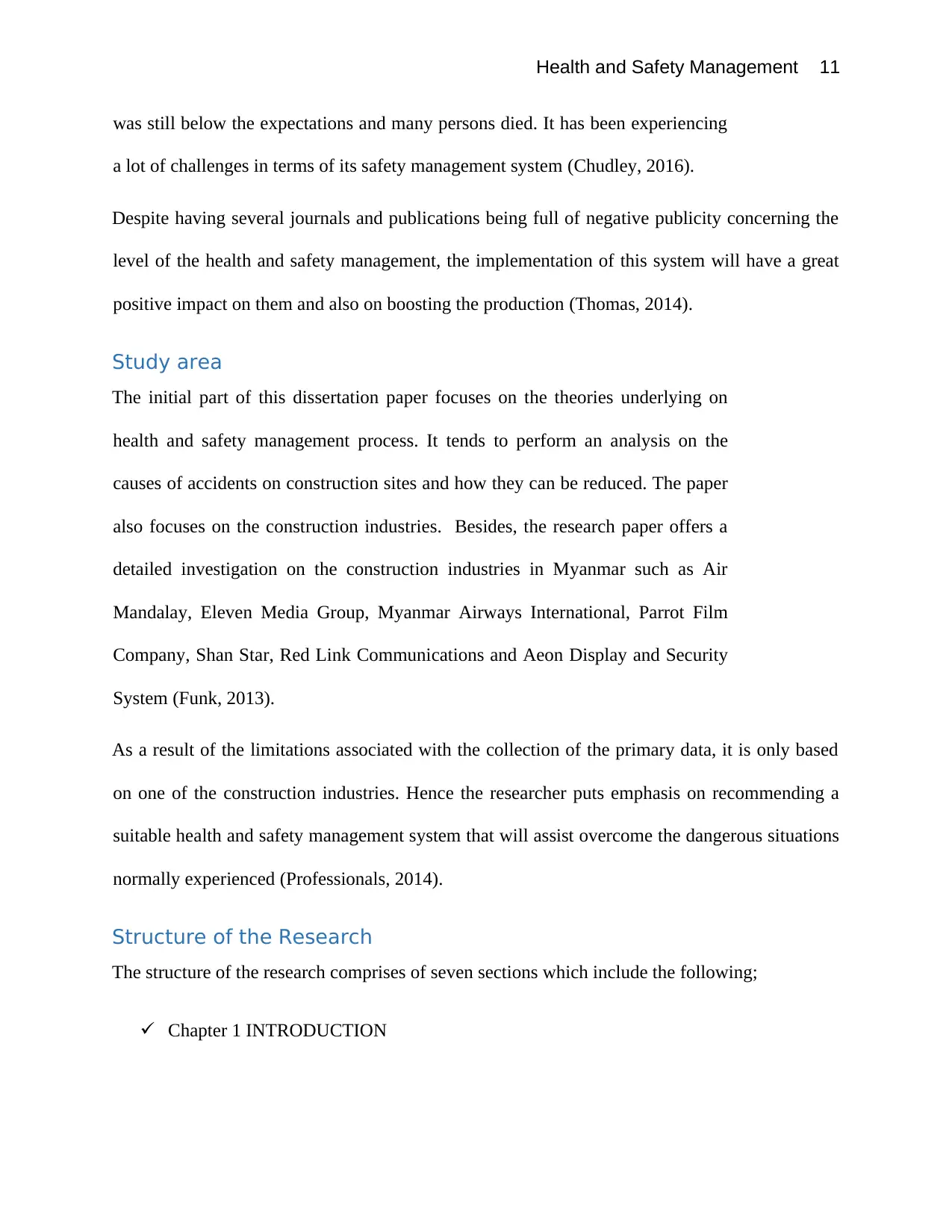
Health and Safety Management 11
was still below the expectations and many persons died. It has been experiencing
a lot of challenges in terms of its safety management system (Chudley, 2016).
Despite having several journals and publications being full of negative publicity concerning the
level of the health and safety management, the implementation of this system will have a great
positive impact on them and also on boosting the production (Thomas, 2014).
Study area
The initial part of this dissertation paper focuses on the theories underlying on
health and safety management process. It tends to perform an analysis on the
causes of accidents on construction sites and how they can be reduced. The paper
also focuses on the construction industries. Besides, the research paper offers a
detailed investigation on the construction industries in Myanmar such as Air
Mandalay, Eleven Media Group, Myanmar Airways International, Parrot Film
Company, Shan Star, Red Link Communications and Aeon Display and Security
System (Funk, 2013).
As a result of the limitations associated with the collection of the primary data, it is only based
on one of the construction industries. Hence the researcher puts emphasis on recommending a
suitable health and safety management system that will assist overcome the dangerous situations
normally experienced (Professionals, 2014).
Structure of the Research
The structure of the research comprises of seven sections which include the following;
Chapter 1 INTRODUCTION
was still below the expectations and many persons died. It has been experiencing
a lot of challenges in terms of its safety management system (Chudley, 2016).
Despite having several journals and publications being full of negative publicity concerning the
level of the health and safety management, the implementation of this system will have a great
positive impact on them and also on boosting the production (Thomas, 2014).
Study area
The initial part of this dissertation paper focuses on the theories underlying on
health and safety management process. It tends to perform an analysis on the
causes of accidents on construction sites and how they can be reduced. The paper
also focuses on the construction industries. Besides, the research paper offers a
detailed investigation on the construction industries in Myanmar such as Air
Mandalay, Eleven Media Group, Myanmar Airways International, Parrot Film
Company, Shan Star, Red Link Communications and Aeon Display and Security
System (Funk, 2013).
As a result of the limitations associated with the collection of the primary data, it is only based
on one of the construction industries. Hence the researcher puts emphasis on recommending a
suitable health and safety management system that will assist overcome the dangerous situations
normally experienced (Professionals, 2014).
Structure of the Research
The structure of the research comprises of seven sections which include the following;
Chapter 1 INTRODUCTION
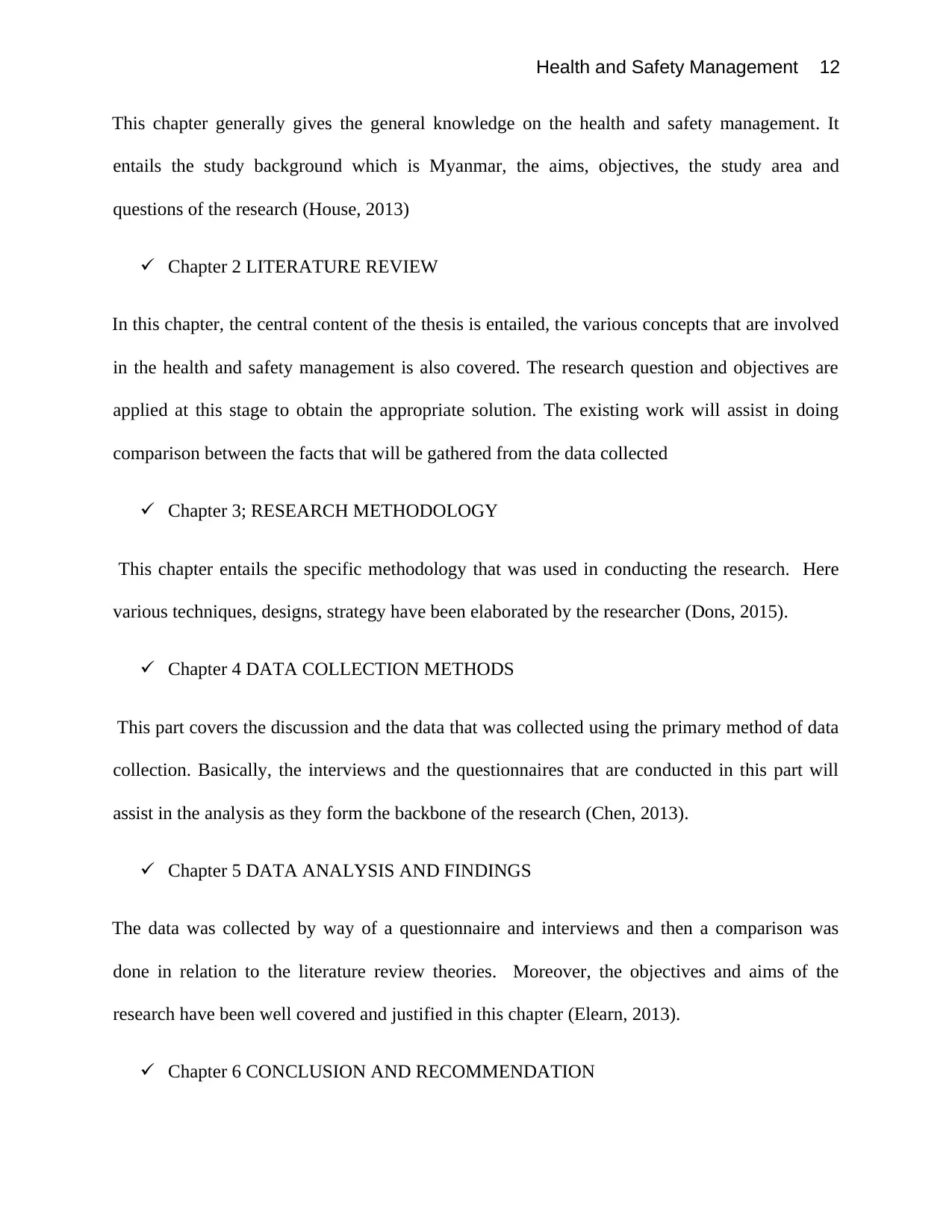
Health and Safety Management 12
This chapter generally gives the general knowledge on the health and safety management. It
entails the study background which is Myanmar, the aims, objectives, the study area and
questions of the research (House, 2013)
Chapter 2 LITERATURE REVIEW
In this chapter, the central content of the thesis is entailed, the various concepts that are involved
in the health and safety management is also covered. The research question and objectives are
applied at this stage to obtain the appropriate solution. The existing work will assist in doing
comparison between the facts that will be gathered from the data collected
Chapter 3; RESEARCH METHODOLOGY
This chapter entails the specific methodology that was used in conducting the research. Here
various techniques, designs, strategy have been elaborated by the researcher (Dons, 2015).
Chapter 4 DATA COLLECTION METHODS
This part covers the discussion and the data that was collected using the primary method of data
collection. Basically, the interviews and the questionnaires that are conducted in this part will
assist in the analysis as they form the backbone of the research (Chen, 2013).
Chapter 5 DATA ANALYSIS AND FINDINGS
The data was collected by way of a questionnaire and interviews and then a comparison was
done in relation to the literature review theories. Moreover, the objectives and aims of the
research have been well covered and justified in this chapter (Elearn, 2013).
Chapter 6 CONCLUSION AND RECOMMENDATION
This chapter generally gives the general knowledge on the health and safety management. It
entails the study background which is Myanmar, the aims, objectives, the study area and
questions of the research (House, 2013)
Chapter 2 LITERATURE REVIEW
In this chapter, the central content of the thesis is entailed, the various concepts that are involved
in the health and safety management is also covered. The research question and objectives are
applied at this stage to obtain the appropriate solution. The existing work will assist in doing
comparison between the facts that will be gathered from the data collected
Chapter 3; RESEARCH METHODOLOGY
This chapter entails the specific methodology that was used in conducting the research. Here
various techniques, designs, strategy have been elaborated by the researcher (Dons, 2015).
Chapter 4 DATA COLLECTION METHODS
This part covers the discussion and the data that was collected using the primary method of data
collection. Basically, the interviews and the questionnaires that are conducted in this part will
assist in the analysis as they form the backbone of the research (Chen, 2013).
Chapter 5 DATA ANALYSIS AND FINDINGS
The data was collected by way of a questionnaire and interviews and then a comparison was
done in relation to the literature review theories. Moreover, the objectives and aims of the
research have been well covered and justified in this chapter (Elearn, 2013).
Chapter 6 CONCLUSION AND RECOMMENDATION
⊘ This is a preview!⊘
Do you want full access?
Subscribe today to unlock all pages.

Trusted by 1+ million students worldwide
1 out of 81
Related Documents
Your All-in-One AI-Powered Toolkit for Academic Success.
+13062052269
info@desklib.com
Available 24*7 on WhatsApp / Email
![[object Object]](/_next/static/media/star-bottom.7253800d.svg)
Unlock your academic potential
Copyright © 2020–2025 A2Z Services. All Rights Reserved. Developed and managed by ZUCOL.





